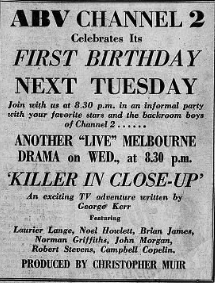Related Research Articles
The year 1964 in television involved some significant events. Below is a list of television-related events which occurred in that year.
The year 1959 in television involved some significant events. Below is a list of television-related events during 1959.
The year 1958 in television involved some significant events. Below is a list of television-related events during 1958.
The year 1956 in television involved some significant events. Below is a list of television-related events during 1956.
GTV is a commercial television station in Melbourne, Australia, owned by the Nine Network. The station is currently based at studios at 717 Bourke Street, Docklands. GTV-9 is the home of the Australian Open tennis coverage.
Francis William Thring IV was an Australian character actor in radio, stage, television and film; as well as a theatre director. His early career started in London in theatre productions, before he starred in Hollywood film, where he became best known for roles in Ben-Hur in 1959 and King of Kings in 1961. He was known for always wearing black and styling his home in black decor.

Father Knows Best is an American sitcom starring Robert Young, Jane Wyatt, Elinor Donahue, Billy Gray and Lauren Chapin. The series, which began on radio in 1949, aired as a television show for six seasons and 203 episodes. Created by Ed James, Father Knows Best follows the lives of the Andersons, a middle-class family living in the town of Springfield. The state in which Springfield is located is never specified, but it is generally accepted to be located in the Midwestern United States.

Albert Watson Newton was an Australian media personality. He was a Logie Hall of Fame inductee, quadruple Gold Logie–winning entertainer, and radio, theatre, and television personality and compère.
1959 in Australian television was the fourth year of television broadcasts in Australia.
Hal Lashwood's Alabama Jubilee was an Australian television variety series hosted by Hal Lashwood which aired from 1958 to 1961 on ABC Television. It was essentially a minstrel show, with some of the performers appearing in blackface makeup. In 1960, it was retitled Hal Lashwood's Minstrels.
Take That was one of the earliest Australian television series. It debuted in late 1957 and ran till March 1959. As was often the case with early Australian television, it aired only on a single station, in this case HSV-7, in Melbourne.
Swallows Parade was an Australian radio and television series. The radio version was broadcast by Melbourne station 3DB in the 1950s, and was also heard on other Major Broadcasting Network stations on a Thursday evening, with auditions being held on Tuesdays. It was presented in front of a live audience from various towns and cities with Major Network outlets.
Make Ours Music was an Australian music television series which aired from 1958 to circa 1961 on ABC. Produced in Sydney, it also aired in Melbourne. Originally a half-hour series, it later expanded to an hour. Make Ours Music featured a mix of live songs and dance numbers.
What's in the Picture is an Australian television panel game show which aired on ABC from 1958 to 1959. Produced and broadcast live in Sydney, it was also shown in Melbourne via telerecordings, a type of recording also known as a kinescope recordings. The series was hosted by Harry Dearth, and aired in a half-hour time-slot.
The Late Show is an Australian television variety series which aired from 1957 to 1959 on Melbourne station HSV-7. Aired on Tuesdays, Wednesdays and Thursdays and competing in the time-slot with GTV-9's popular In Melbourne Tonight, the series included a mix of music and comedy. People who hosted the series during its run included John D'Arcy, Bert Newton and original host Noel Ferrier.
My Fair Lady was an Australian television series which aired from 1958 through to the Sixties on multiple television stations.
Movie Guide was an Australian television program which aired on Melbourne station HSV-7 from 29 August 1958 to 24 July 1959.
Strictly for Mothers was an Australian television series, which aired on Melbourne television station HSV-7. The weekly half-hour daytime series was short-lived, broadcast on Mondays from 27 July 1959 to 12 October 1959 at 2:45PM. It was a series aimed at mothers and expectant mothers. It was hosted by Jean Battersby. It was followed on HSV-7's schedule by Snakes and Ladders, a short-lived game show.
Personal Column is an Australian television program. It aired on Melbourne station HSV-7, broadcast weekly at 4:00PM on Wednesdays from 27 August 1958 to 6 May 1959. Episodes aired in a 15-minute time-slot. It was replaced on the schedule by Brenda's Time with HSV personality Brenda Marshall, a program about which very little information is available. The archival status of either program is not known. It should not be confused with Personal Album, a GTV-9 series which also aired from 1958 to 1959.

Killer in Close-Up was a blanket title covering four live television drama plays produced by the Australian Broadcasting Commission in 1957 and 1958. It could be seen as the first anthology series produced for Australian television.
References
- ↑ "Friday Television". The Age . Melbourne. 6 June 1958. p. 6. Retrieved 27 May 2018.
- ↑ "Monday Television". The Age . Melbourne. 26 February 1959. Retrieved 27 May 2018.